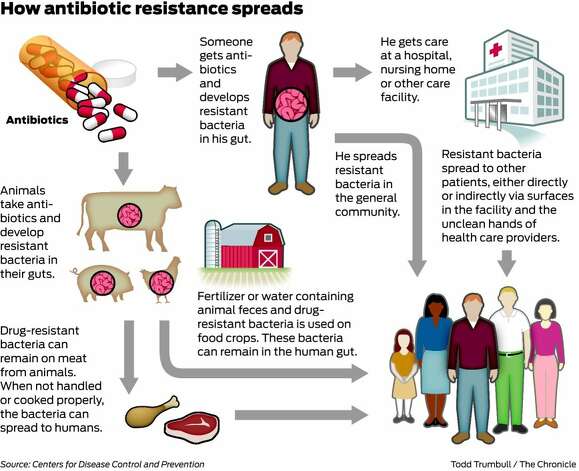
The Centers for Disease Control on Monday confirmed a link between routine use of antibiotics in livestock and growing bacterial resistance that is killing at least 23,000 people a year.
The report is the first by the government to estimate how many people die annually of infections that no longer respond to antibiotics because of overuse in people and animals. CDC Director Thomas Frieden called for urgent steps to scale back and monitor use, or risk reverting to an era when common bacterial infections of the urinary tract, bloodstream, respiratory system and skin routinely killed and maimed.
"We will soon be in a post-antibiotic era if we're not careful," Frieden said. "For some patients and some microbes, we are already there."

In this undated photo provided by the Centers for Disease Control and Prevention is one form of CRE bacteria, sometimes called ?nightmare bacteria.? CRE bacteria is blamed for 600 deaths each year, and can withstand treatment from virtually every type of antibiotic.
Along with the annual fatalities, the report estimated at least 2 million antibiotic-resistant infections occur each year. Frieden said these are "minimal estimates" because they count only microbes that are resistant to multiple antibiotics and include only hospital infections, omitting cases from dialysis centers, nursing homes and other medical settings.
At least 70 percent of all antibiotics in the United States are used to speed growth of farm animals or to prevent diseases among animals raised in feedlots. Routine low doses administered to large numbers of animals provide ideal conditions for microbes to develop resistance.
The pharmaceutical and livestock industries have long disputed any such linkage. But the report called for phasing out such uses.
Beyond turning common infections deadly, the rise of antibiotic resistance would undermine much of modern medicine. Organ transplants, joint replacements, cancer therapies and the use of catheters, respirators and other invasive procedures and devices would be impossible because of the risk of infection.
The link between overuse of antibiotics in livestock and microbial resistance has been suspected since the 1960s, but Congress, at the behest of the pharmaceutical and livestock industries, has blocked efforts by the Food and Drug Administration to scale back their use.
Commercial livestock have to be fed the drugs because of the crowded conditions in which they are raised.
"If you have a healthy cow foraged on grass, and if they are in a clean field environment, your cows are not going to get sick. When you cram them into huge feedlots, they start getting sick because there are too many of them in too small a space."
http://www.sfgate.com/health/article...#photo-5195177
Comment